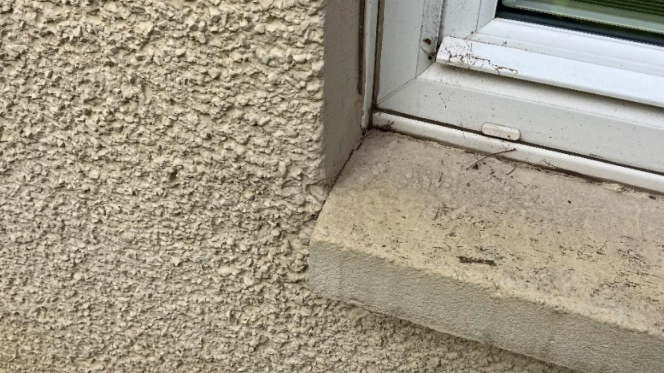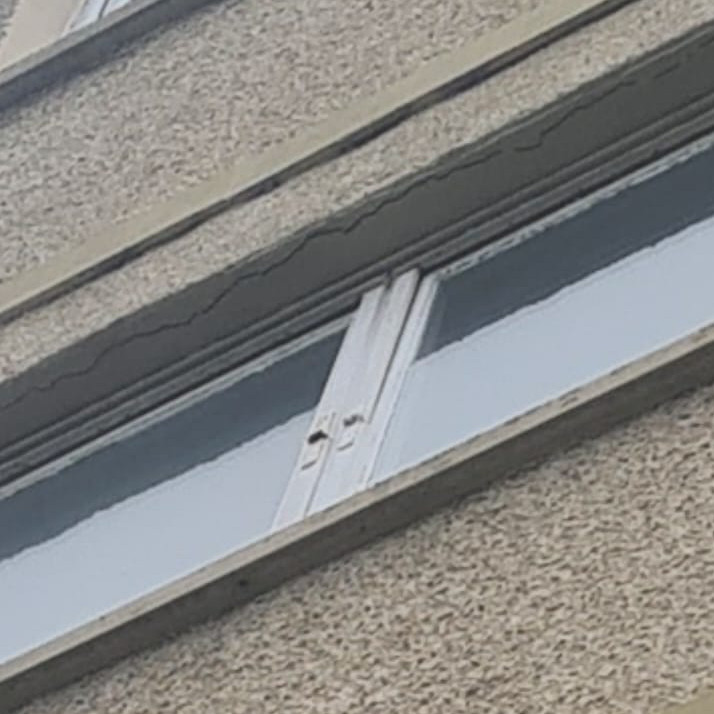
Indepth analysis of Thomasons tender document for the window sills
Before retiring, Ken Boyter worked as a maintenance manager at Grangemouth, where he reviewed proposals for works. An important responsibility was ensuring projects offered value for money and kept on budget through a process called value engineering. In keeping with his experience, Kenny has produced a value engineering report for us, below:
Summary of Findings
Cracking above windows overlooked
- The initial survey failed to identify cracking above the windows, which suggests damage to the lintels (structural supports) above the windows.

Failure to Prioritise Queens Park Court Building Safety
- Despite requests, no list of priority works has been provided.
Inconsistent Documentation
- A comparison between the bill of quantities and the accompanying drawings from Thomasons reveals discrepancies, including:
- Double counting windowsills.
- Making the scope of proposed work unclear.
Tender Overspecifies Work to Make the Job More Financially Attractive
- The tender advises replacing 55 windowsills, but only 28 need replacement.
- Short sills are to be replaced with short sills again.
- Every windowsill over the two blocks is to be charged with removal of moss and painting, whether it is necessary or not.
- The tender does not invite bidders to propose alternative ways to access the building (e.g., cherry picker), implying that works start at a minimum of £100,000 in scaffolding costs.
- Windowsills that have not had problems since the building’s construction (1965) are proposed for replacement. See table 1, below
- The tender details separate prices to inflate costs, including individual charges for:
- Cutting out defective windowsills.
- Raking out mastic on defective windowsills.
- Installing new windowsills.
- Applying mastic on new windowsills.
- Cleaning every windowsill (including non-defective ones).
- Painting every windowsill (including non-defective ones).
| Category | Description | East elevation | North elevation | South elevation | West elevation |
|---|---|---|---|---|---|
| 1 | Short sill | 0 | 0 | 10 | 2 |
| 2 | Mortar damage | 2 | 10 | 1 | 11 |
| 3 | Hairline crack | 0 | 7 | 5 | 12 |
| 4 | Extensive crack | 1 | 2 | 0 | 3 |
| 5 | Paintwork flake | 3 | 0 | 0 | 2 |
| 6 | Moss | 1 | 5 | 0 | 2 |
| 7 | Previously replaced | 2 | 0 | 2 | 0 |
| 8 | No dripaway | 2 | 0 | 0 | 0 |
| 9 | Section missing | 0 | 0 | 0 | 2 |
Table 1: A count of the of the window sills by category and their coresponding location
It is ours and Heritage Stone Masons Edinburgh’s opinion that window sills in categories 3, 4 and 9 need replacing and catagory 1, short sills can easily be repaired. The replacements proposed for category 1 short sills in the tender document would be of the same length. Repair would be a cheaper option and pose less risk of damage to the building and underlying damp proof membrane. These short sills have not allowed damp to penetrate since the building was constructed more than 60 years ago. After eliminating short sills and double counts (see below, “The Numbers don’t Add Up”) that were found between the survey and the tender document, the total sill with cracks or sections missing is 28. Not the 55 that the tender document specifies for replacement.
Dubious Project Management Costs
- Thomasons have billed for project management hours despite no approval or initiation of work.
- Their fee includes an unspecified percentage of the estimated costs of the work. As the overall project cost increases, so too does the project management fee, raising concerns about a conflict of interest.
Contradictions in Scaffolding Specification
- There are contradictions between the surveyors’ tender report and the quote from Noble Property solutions as recommended by Thomasons regarding scaffolding:
- The tender report specifies wrapping the building in scaffolding, which incurs high costs.
- The builder’s quote proposes a scaffolding tower instead, as a cost-saving measure.
- By way of comparison, a 12-meter scaffolding tower (covering ground, 1st, 2nd, and 3rd floors) has a 4-week hire cost of £665.90 (plus VAT). This is significantly lower than the tender’s implied £100,000+ for full building scaffolding.
Lack of Transparency in the Quote and Tender Documents
- The enabling works section totals £46,708.00, but the purpose of these works is unclear.
- There is no explanation of what this sum covers or how it was calculated.
- The high cost is particularly questionable given the builder’s attempt to save costs by specifying the use of a scaffolding tower.
Detailed Findings
Missed Opportunity for Comprehensive Repairs
- Lintels, that support the brickwork above the sills, were overlooked in the survey.
Given that the cost of enabling works makes up a significant portion of the budget, addressing all essential repairs simultaneously would be more cost-effective.
The Numbers Don’t Add Up
- The Inspection Report (dated November 2023) identifies windowsills in 9 distinct categories. There are 3 categories indicating replacement:
- Two of these are for cracks (Section 3.2 and 3.3).
- One is for sills which are too short (Section 3.4).
- The drawings provided in the inspection report use a different labelling system, numbered 1–9:
- Three categories identify sills that are damaged (3, 4, and 9).
- Our count of these labels is:
- 24 in category 3.
- 5 in category 4.
- 2 in category 9.
- Removing double-counted windowsills, there are a total of 28 windowsills in categories 3, 4, or 9.
- There are 12 category 1 windowsills (short windowsills).
- This gives a total of 40 windowsills to be replaced (according to Thomasons).
- In the tender document (page 34), we are being charged for 55 sills to be replaced.
The Tender is Insufficiently Clear
- The drawings do not label sills that need only mastic replacement.
- The tender asks for a price for 55 sills to be removed.
- The tender also asks for a price for 55 windowsills to have new mastic.
Specification to Inflate Costs
- Use of scaffolding:
- The tender fails to invite bidders to propose alternative methods to access the windowsills.
By default, the tender proposes the cost of scaffolding, which sets the cost of the work to a minimum of £100,000. - Replacement of Windowsills:
- The tender document recommends the replacement of 55 windowsills, but only 28 are counted as cracked or damaged.
- The 12 ‘short’ windowsills are not defective and are in fact standard non-stooled type (i.e., they simply appear short to the eye).
- The report advises these windowsills pose a risk for water ingress, but they have not let water in since the building was constructed (1965).
- The 12 identified ‘short’ windowsills simply need sealing.
- Thomasons proposes to replace the ‘short’ windowsills with short windowsills again (to match the style of the building).
- Preventative works, such as mastic or mortar to the ends of the 12 identified windowsills, would be a lower-cost option and would prevent any damage to the underlying damp-proofing that can happen during the removal of sills.
- Moss on Windowsills:
- Thomasons’ tender invites contractors to clean and paint every single windowsill across the two blocks, which is unnecessarily costly.
- Overspecified Line Items to Increase Costs:
- Thomasons break the work down into separate line items to inflate the costs and make the work more financially attractive. There is an individual price for:
- Cutting out defective windowsills (quantity: 55).
- Installing new windowsills (quantity: 55).
- Raking out mastic (quantity: 55).
- Applying new mastic (quantity: 55).
- Cleaning moss off windowsills (quantity: 55).
- Painting windowsills (quantity: 55).
- Thomasons break the work down into separate line items to inflate the costs and make the work more financially attractive. There is an individual price for:
- The tender fails to invite bidders to propose alternative methods to access the windowsills.
Unanswered Requests for Clarification
- On October 4th, Kenny emailed James Gibb requesting the following:
- A prioritization of repairs.
- A detailed breakdown of Thomasons’ and contractors’ costs.
- Properly marked-up drawings to align with the bill of quantities.
- To date, no response has been received.
Broader Concerns
- The original request aimed to address a safety issue after part of a windowsill fell to the ground.
- Over the course of more than a year, this has evolved into discussions about:
- Moss on sills.
- Cracked paint.
- Replacing components that have not caused any damp.
- We still do not have a prioritised list of essential repairs to ensure our safety.
- This report highlights inefficiencies and miscommunications, emphasising the need for clarity and focus on critical issues rather than unnecessary work.
- Over the course of more than a year, this has evolved into discussions about: